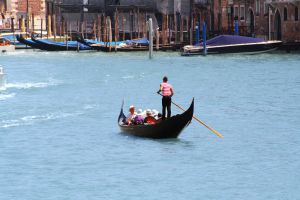Mark Twain’s take on the gondola
Mark Twain’s take on the gondola
Mark Twain’s take on the gondola
-
Hannah
-
Hannah
 Have you read The Innocents Abroad? It depicts famous American writer Mark Twain’s journey through Europe and the Holy Land, with startlingly crisp detail, Twain’s trademark twang of irreverent humour and some poignant philosophising, such as, ‘Human nature appears to be just the same, all over the world.’ In fact, it was his bestselling book in his lifetime, and it remains one of the most bought travel books in history.
Have you read The Innocents Abroad? It depicts famous American writer Mark Twain’s journey through Europe and the Holy Land, with startlingly crisp detail, Twain’s trademark twang of irreverent humour and some poignant philosophising, such as, ‘Human nature appears to be just the same, all over the world.’ In fact, it was his bestselling book in his lifetime, and it remains one of the most bought travel books in history.
Venice was one stop on Twain’s trip, and in Chapter 23 he gives a wonderful description of the gondola which is as relevant today as it was then, in 1869, when the book was first published. It’s a superb piece of literature, I’m sure you’ll agree.
The Venetian gondola is as free and graceful, in its gliding movement, as a serpent. It is twenty or thirty feet long, and is narrow and deep, like a canoe; its sharp bow and stern sweep upward from the water like the horns of a crescent with the abruptness of the curve slightly modified.
The bow is ornamented with a steel comb with a battle-ax attachment which threatens to cut passing boats in two occasionally, but never does. The gondola is painted black because in the zenith of Venetian magnificence the gondolas became too gorgeous altogether, and the Senate decreed that all such display must cease, and a solemn, unembellished black be substituted. If the truth were known, it would doubtless appear that rich plebeians grew too prominent in their affectation of patrician show on the Grand Canal, and required a wholesome snubbing. Reverence for the hallowed Past and its traditions keeps the dismal fashion in force now that the compulsion exists no longer. So let it remain. It is the color of mourning. Venice mourns. The stern of the boat is decked over and the gondolier stands there. He uses a single oar–a long blade, of course, for he stands nearly erect. A wooden peg, a foot and a half high, with two slight crooks or curves in one side of it and one in the other, projects above the starboard gunwale. Against that peg the gondolier takes a purchase with his oar, changing it at intervals to the other side of the peg or dropping it into another of the crooks, as the steering of the craft may demand–and how in the world he can back and fill, shoot straight ahead, or flirt suddenly around a corner, and make the oar stay in those insignificant notches, is a problem to me and a never diminishing matter of interest. I am afraid I study the gondolier’s marvelous skill more than I do the sculptured palaces we glide among. He cuts a corner so closely, now and then, or misses another gondola by such an imperceptible hair-breadth that I feel myself “scrooching,” as the children say, just as one does when a buggy wheel grazes his elbow. But he makes all his calculations with the nicest precision, and goes darting in and out among a Broadway confusion of busy craft with the easy confidence of the educated hackman. He never makes a mistake.